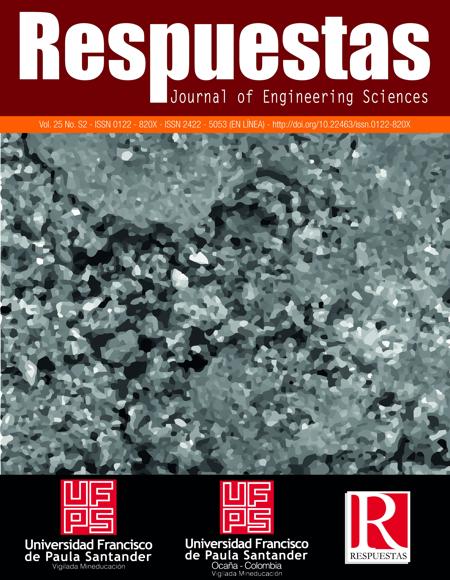Characterization of plastic soil for stabilization with cementing
Caracterización de un suelo plástico para estabilización con cementantes Characterization of plastic soil for stabilization with cementing
Main Article Content
Soils with a significant content of clay material and high plasticity are related to a particular behavior that presents with problems of low resistance to cutting, excessive volumetric changes, and high deformability. As regards the previous studies conducted for any infrastructure project, the typology of the soils present should be identified and characterized. With the development of research it seeks to carry out the characterization of a typical plastic soil, the territorial roads, the municipality of Ocaña, and the possibility of improving the potential of the cement, identifying their physical, mechanical and chemical characteristics. For this purpose, a composition composed of 3 stages is proposed: Recognition of the sampling site, laboratory tests and analysis of results. The results are related to the soil according to the unified system as an MH (clay loam of high plasticity), with Liquid Limit = 61.7%, Plastic Limit = 44.9% and Plasticity Index= 16.78%, with a specific gravity of 2.78 and unit weight of 1.382 g /cm3, optimum humidity of 31.07% and maximum dry density of 1.43 g /cm3. As for the mechanical characteristics, it has an average friction angle of 20.25 °, the cohesion of 18.11 kPa, unconfined compression resistance of 135.61 kPa and an index of CBR = 5.37. The relationship with the chemical characteristics, the soil has a cationic exchange capacity of 46.1 meq / 100g soil and a pH = 6.9. With the EDS analysis, the main element present in the soil is oxygen, followed by silicon and aluminum. There is also a noticeable presence of iron oxide. In conclusion, the study floor meets the characteristics of a soil that can present deformation problems for moisture values, which is susceptible, in addition to its physical and chemical characteristics, to stabilize with cement.
Downloads
Article Details
A. Sabtan, “Geotechnical properties of expansive clay shale in Tabuk, Saudi Arabia”, Journal of Asian Earth Sciences Vol. 25, no. 5, pp.747–757, 2005.
R. Huang y L. Wu, “Stability analysis of unsaturated expansive soil slope”, Earth Science Frontiers, vol. 14, no. 6, pp. 129–133, 2007.
C. Higuera, J. Gómez y O. Pardo, “Caracterización de un suelo arcilloso tratado con hidróxido de calcio”. Revista Facultad de Ingeniería, UPTC, vol. 21, no. 32, pp. 21-40, 2012. [Online]. Disponible en: https://revistas.uptc.edu.co/index.php/ingenieria/article/view/1431/1426 (2012).
S. Fityus, O. Buzzi, “The place of expansive clays in the framework of unsaturated soil mechanics”. Applied Clay Science, vol. 43, no.2, pp 150–155. 2009
Z. Nalbantoglu, “Effectiveness of Class C fly ash as an expansive soil stabilizer”, Construction and Building Materials, vol. 18, no. 6, pp. 377–381, 2004.
A. Assadi, S. Shahaboddin, “A micro-mechanical approach to swelling behavior of unsaturated expansive clays under controlled drainage conditions”, Applied Clay Science, vol. 45, no.2, pp. 8–19, 2009
E. Avsar, R. Ulusay, y H. Sonmez, “Assessments of swelling anisotropy of Ankara clay”, Engineering Geology, vol. 105, no. 1–2, pp. 24–31, 2009
V. Ferber, J. C. Auriol, Y. J. Cui, y J. P. Magnan, “On the swelling potential of compacted high plasticity clays”, Engineering Geology, vol. 104, no. 3, pp. 200–210, 2009.
E. S. Seif, “Efficiency of quicklime in reducing the swelling potential of pulverized expansive shale, Northern Jeddah, Saudi Arabia”, Bulletin of Engineering Geology and the Environment, vol 74, no. 2, pp. 637-650, 2015.
L. Chen, Z. Yin, P. Zhang, “Relationship of resistivity with water content and fissures of unsaturated expansive soils”, Journal of China University of Mining and Technology, vol. 17, no.4, pp. 537–540, 2007.
Corporación Andina de Fomento – CAF, “Soluciones e innovaciones tecnológicas de mejoramiento de vías de bajo tránsito”, Serie informes sectoriales. Infraestructura, (Caracas), 2010. [Online]. Disponible en http://scioteca.caf.com/handle/123456789/401
D. K. Kuttah, Improving low-volume road construction and performance: Validity of using the heavy vehicle simulator in evaluating the reinforcement of low-volume roads. Linköping: VTI, Statens väg och transportforskningsinstitut, 2013.
A. Eisazadeh, K. A. Kassim, y H. Nur, “Molecular characteristics of phosphoric acid treated soils”, World Academy of Science, Engineering and Technology, vol. 4, no. 3, pp. 56-58, 2010.
A. Marto, N. Latifi, y H. Sohaei, “Stabilization of laterite soil using GKS soil stabilizer”, Electronic Journal of Geotechnical Engineering, vol. 18, no. 1, pp. 521-532, 2013.
A. E. Ramaji, “A review on the soil stabilization using low-cost methods”. Journal of Applied Sciences Research, vol. 8, no. 4, pp. 2193-2196, 2012.
B. V. Rao, V. Reddy, y M. Muttharam, “The impact of cyclic wetting and drying on the swelling behaviour of stabilized expansive soils”. Engineering Geology, vol. 60, no1–4, pp. 223–233, 2001.
R. N. Yong, V. R. Ouhadi. “Experimental study on instability of bases on natural and lime/cement-stabilized clayey soils”, Applied Clay Science, vol. 35, no. 3–4, pp. 238–249, 2007.
A. Seco, F. Ramírez, L, Miqueleiz, y B. García, “Stabilization of expansive soils for use in construction”. Applied Clay Science, vol. 51, no. 3, pp. 348-352, 2011.
Y. Du, S. Li, S. Hayashi, “Swelling-shrinkage properties and soil improvement of compacted expansive soil,Ning-Liang Highway, China”. Engineering Geology, vol. 53, no. 3–4, pp. 351–358, 1999.
F. Yazdandoust, S. Yasrobi, “Effect of cyclic wetting and drying on swelling behavior of polymer-stabilized expansive clays”, Applied Clay Science, vol. 50, no. 4, pp. 461- 468, 2010.
D. Lin, K. Lin, M. Hung, y H. Luo, “Sludge ash/hydrated lime on the geotechnical properties of soft soil”, Journal of HazardousMaterials, vol. 145, no. 1–2, pp. 58–64, 2007.
L. Chen, D. Lin, “Stabilization treatment of soft subgrade soil by sewage sludge ash and cement”. Journal of Hazardous Materials, vol. 162, no. 1, pp. 321–327, 2009.
Y. Guney, D. Sari, M. Cetin, y M. Tuncan, “Impact of cyclicwetting-drying on swelling behavior of lime-stabilized soil”. Building and Environment. Vol. 42, no. 2, pp. 681–688, 2007.
J. Monzón, “Influencia del comportamiento viscoso de arcillas sobre el módulo resiliente y la deformación permanente de subrasantes”, Trabajo fin de pregrado, Pontificia Universidad Javeriana, Bogotá, Colombia, 2012.


